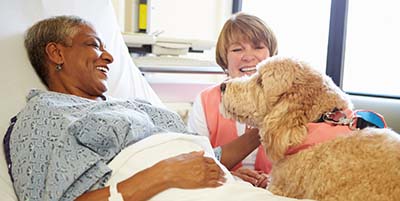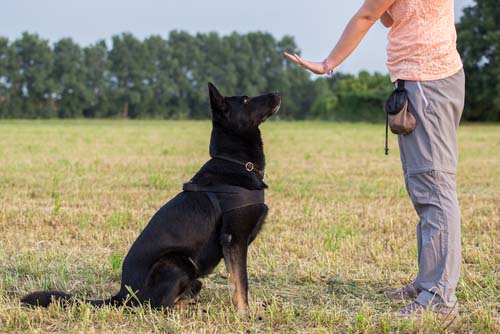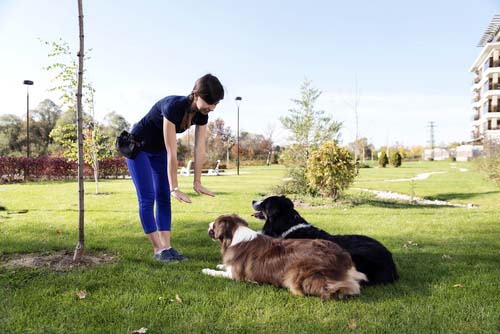Therapy dogs are in high demand because of the massive impact they have on those struggling within a community. If you want to join the club and let your doggo share its calming comfort with others, therapy dog training is the right place to start!
Read on to find out about the required qualities and training that these canine heroes!
What is the Difference Between ESAs, Service, and Therapy Dogs?
At first, it might be easy to confuse all three categories of canines as simply highly trained dogs, a little more advanced than family dogs who can play fetch. However, the three groups are rather different and must not be confused.
Emotional Support Animal (ESA) – An emotional support animal (usually a dog or a cat) is an animal that does not need specific training. They help people with mental illness or emotional conditions, such as post-traumatic stress disorder (PTSD), simply by providing comfort and companionship.
What separates ESAs from other groups and pets, is an ESA letter from a licensed mental health professional, which states that the animal gives emotional support for a diagnosed condition. They also fall under different legal protection than service and therapy animals.
Service Dog – A service dog is extensively trained to perform specific tasks for people with disabilities. One of the most common examples of a service dog is a seeing-eye dog who helps people with visual impairments.
Therapy Dog – The third type, a therapy dog, gives comfort and rehabilitation in a more public setting, such as a nursing home, hospital or school. Technically they are not extensively trained, but they do require basic obedience training such as the Canine Good Citizen course.
Can Emotional Support Animals Also Be Therapy Animals?
Absolutely! An emotional support dog is great at making people feel better by default. It’s simply what they do! As mentioned, an ESA does not need to have specific training to become an ESA. If you think your ESA has what it takes to spread happiness, joy and comforting company to those who need it most, why not train them up to become a therapy dog?
If your dog or cat excels at the task of providing you with emotional support, why not make it official and make them an ESA? That way they will be allowed to travel with you on flights (free of charge) and live with you in rented accommodation (despite that “no-pet” policy). You can be together at all times!
The first step to getting an ESA letter is as easy as taking CertaPet’s free online 5-minute pre-screening to see whether you qualify. If your answers indicate that you do, CertaPet will connect you with a licensed mental health professional, and you could have your ESA letter in as little as 48 hrs!
The Main Categories Therapy Dogs Fall Under and What They Entail
There are two main categories of therapy that dogs fall under. The therapy dog training will depend on what type of therapy work they will be taking part in.

Animal Assisted Therapy
Animal Assisted Therapy (AAT) is a rehabilitation process that includes using an animal as part of a specific treatment plan. Interactions are designed with the therapy dog in mind, to help a patient heal from physical or psychological trauma.
This might be as simple as playing with fetch with a patient who needs to relearn motor skills or hand and eye coordination. It can also involve a patient stroking the animal and feeling safe and calmed by their presence during psychotherapy.
The additional mental health benefits of the interaction are a positive bonus and encourage the patient to push through difficulties. Cute fur faces are great motivators!
Animal Assisted Activities Therapy
Animal Assisted Activities Therapy (AAA) is a little different. It is less structured. Dogs in this category take part in visitations and activities through outings to facilities or institutions where people can benefit from interacting with animals.
Think about places that need joy such as nursing homes or hospitals. That is where AAA makes its big impact. Dogs also visit schools or libraries to help children practice their reading in front of a happy, non-judgemental being!
The 6 Common Characteristics that Therapy Dogs Share!
Any dog can become an emotional support dog, but seeing as though therapy dogs interact with the public, there are a few boxes that potential therapy dogs need to check before earning the therapy dog title!
- Friendly – The most obvious trait is that the dog is friendly. They must prefer to lick rather than bite. They need to be OK with being handled by strangers (in all areas of the body) and never snap at a human. You will not always be able to control the way people handle your dog, but you need to be able to control your dog!
- Confident – The dog must be okay with new experiences, new smells and most of all, new people. A scared dog is a recipe for disaster. People often confuse a scared dog for an aggressive dog.
- Quiet – We love it when our dogs show excitement when we come home, but yelping and howling are not OK for a therapy dog. They might be asked to “speak” on command, but it is better for them to be cool and quiet.
- Explorative – The dog should love to explore their surroundings and not be upset to leave home.
- Disciplined – Whilst the dog will be receiving therapy dog training, its important that they already have a baseline of discipline, that they are comfortable with receiving commands and believe that they are part of the pack. This also ties into believing that you are an authority.
- Healthy and Vaccinated – As the dog will be interacting in all manner of new places, it is important to ensure that they are fully vaccinated, healthy and fixed.
Therapy Dog Training 101: The 7 Most Important Commands to Teach a Therapy Animal
Therapy dog training begins with your dog understanding these seven basic commands. As cool as it is showing off fun tricks your dog can do, obedience is the number 1 priority. You need to trust that your dog will obey the following commands instantly and without hesitation:
- Recall – When you call your dog to you, they need to come. Immediately.
- Sit – This is an easy one for most dogs. There will be times when you are communicating with staff or patients, and your dog will need to patiently sit by your side and await further instructions.
- Stay – This is the golden command. A good “stay” means that your dog will not move out of its position unless you release them. It does not matter if there is a squirrel a meter away from it, or if there is a piece of bacon lying just out of its reach: the dog must stay put!
- Down –Like with the sit, your dog needs to know that when they are in a “down” position, they are expected to stay there. This is a useful command for therapy dogs who work with groups of children who sit near them and want to pet or read to your dog.
- Leave It – Leave it is a command that tells your dog to leave whatever it is they are interested in, sniffing, or trying to put in their mouth. If, for example, a dog is too interested in a pill bottle or some tubes or cables in a hospital, a simple “leave it” will tell them to leave it alone!
- Visit – This is a fun one, especially for the people who want to pet the dog. “Visit” usually means a dog will put their chin on someone’s leg or lap and allow the person to pet them.
- Gently – Some pups are more boisterous than others. “Gently” is a command that teaches a dog to take the energy levels down a few notches. This is an important command for dogs visiting small children, the frail and the very ill.

Tips on How to Train any Dog to Do Anything!
Positive reinforcement. It is the most powerful tool in training any dog to do anything. By using positive reinforcement (rewarding good behavior with treats or toys) makes dogs WANT to learn and obey.
Another tip when it comes to dog training is to keep the sessions short. Mental stimulation is more tiring than physical exercise is for dogs. Rather break the training sessions into smaller chunks, than going at it for an hour and thereby frying your dog’s brain.
The Importance of Positive Reinforcement!
Toys, treats, and praise go a long way in getting a dog to do what you ask of them. By rewarding their good behavior you are building their confidence. Training should be about having fun and building a stronger bond with your dog, and you won’t get that without positive reinforcement!
The Two Wonderful Laws That Protect ESAs!
There are 2 wonderful federal laws that protect ESAs. Therapy dogs are not protected by these laws, but if your therapy dog is also an ESA, then you’re covered!
The Fair Housing Act
The Federal Fair Housing Act (FHA) protects people with a disability against discrimination based on the fact that they have an ESA. A landlord must provide reasonable accommodation for someone with an ESA, even if there is a “no-pet” policy in place.
The Air Carrier Access Act
The 2nd law that protects ESAs is the Air Carrier Access Act (ACAA). This law allows people with ESAs (mostly cats and dogs) to fly with their animals free of charge. People have been abusing this law by passing pets off as ESAs to get a free light. It’s no surprise that airlines have tightened the rules of allowing ESAs on their flights. If you plan on flying with your ESA, be sure to check the airline’s policy very carefully.

Therapy Dog Training Near Me? You Can Train a Dog Yourself or Join a Group Near You!
Training a dog yourself is definitely possible, but why not join a group or class and meet some new people. At the end of the day, all that matters is that Fido gets the therapy dog training he needs. Once they’re all trained up, you can start spreading joy to those who need it most in your community!
